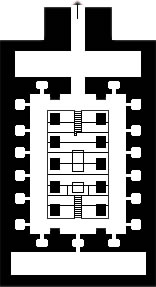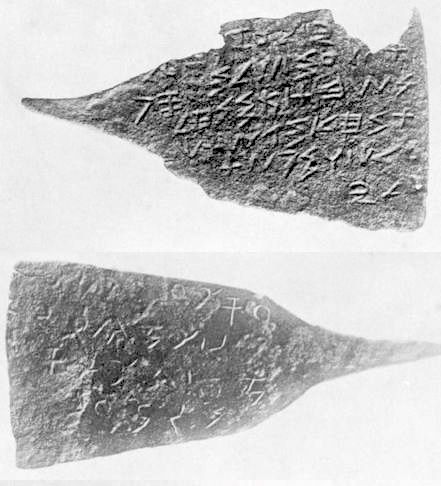|
Abydos Graffiti
The Abydos graffiti is Phoenician and Aramaic graffiti found on the walls of the Temple of Seti I at Abydos, Egypt. The inscriptions are known as KAI 49, CIS I 99-110 and RES 1302ff. Much of the graffiti represents prayers and votive dedications. Prior to the discovery of the Abydos graffiti, very few Semitic inscriptions had been found in Egypt – a few Aramaic texts, the Abu Simbel Phoenician graffiti (published by Ampère, Lepsius, and Graham), and an engraved sphinx found in the Serapeum of Saqqara. Abydos was considered to contain the tomb of Osiris, the god of the afterlife, hence it was considered a holy burial place and attracted pilgrimage. Discovery The first Phoenician and Aramaic graffiti was recorded by Théodule Devéria during Mariette's excavations at Abydos; 13 inscriptions were published in 1868 by Hermann Zotenberg. Heinrich Karl Brugsch subsequently made notes of 16 inscriptions. The inscriptions of Deveria and Brugsch were published in the first edition ... [...More Info...] [...Related Items...] OR: [Wikipedia] [Google] [Baidu] |
Temple Of Seti I At Abydos (IV) (4645121126)
A temple (from the Latin ) is a building reserved for spiritual rituals and activities such as prayer and sacrifice. Religions which erect temples include Christianity (whose temples are typically called churches), Hinduism (whose temples are called Mandir), Buddhism, Sikhism (whose temples are called gurudwara), Jainism (whose temples are sometimes called derasar), Islam (whose temples are called mosques), Judaism (whose temples are called synagogues), Zoroastrianism (whose temples are sometimes called Agiary), the Baha'i Faith (which are often simply referred to as Baha'i House of Worship), Taoism (which are sometimes called Daoguan), Shinto (which are sometimes called Jinja), Confucianism (which are sometimes called the Temple of Confucius), and ancient religions such as the Ancient Egyptian religion and the Ancient Greek religion. The form and function of temples are thus very variable, though they are often considered by believers to be, in some sense, the "hous ... [...More Info...] [...Related Items...] OR: [Wikipedia] [Google] [Baidu] |
Corpus Inscriptionum Semiticarum
The ("Corpus of Semitic Inscriptions", abbreviated CIS) is a collection of ancient inscriptions in Semitic languages produced since the end of 2nd millennium BC until the rise of Islam. It was published in Latin. In a note recovered after his death, Ernest Renan stated that: "Of all I have done, it is the Corpus I like the most." The first part was published in 1881, fourteen years after the beginning of the project. Renan justified the fourteen year delay in the preface to the volume, pointing to the calamity of the Franco-Prussian war and the difficulties that arose in the printing the Phoenician characters, whose first engraving was proven incorrect in light of the inscriptions discovered subsequently. A smaller collection – ("Repertory of Semitic Epigraphy", abbreviated RES) – was subsequently created to present the Semitic inscriptions without delay and in a deliberately concise way as they became known, and was published in French rather than Latin. The was for the ... [...More Info...] [...Related Items...] OR: [Wikipedia] [Google] [Baidu] |
Phoenician Inscriptions
The Canaanite and Aramaic inscriptions, also known as Northwest Semitic inscriptions, are the primary extra-Biblical source for understanding of the society and history of the ancient Phoenicians, Hebrews and Arameans. Semitic inscriptions may occur on stone slabs, pottery ostraca, ornaments, and range from simple names to full texts. The older inscriptions form a Canaanite–Aramaic dialect continuum, exemplified by writings which scholars have struggled to fit into either category, such as the Stele of Zakkur and the Deir Alla Inscription. The Northwest Semitic languages are a language group that contains the Aramaic language, as well as the Canaanite languages including Phoenician and Hebrew. Languages The old Aramaic period (850 to 612 BC) saw the production and dispersal of inscriptions due to the rise of the Arameans as a major force in Ancient Near East. Their language was adopted as an international language of diplomacy, particularly during the late stages of the Ne ... [...More Info...] [...Related Items...] OR: [Wikipedia] [Google] [Baidu] |
1868 Archaeological Discoveries
Events January–March * January 2 – British Expedition to Abyssinia: Robert Napier leads an expedition to free captive British officials and missionaries. * January 3 – The 15-year-old Mutsuhito, Emperor Meiji of Japan, declares the ''Meiji Restoration'', his own restoration to full power, under the influence of supporters from the Chōshū and Satsuma Domains, and against the supporters of the Tokugawa shogunate, triggering the Boshin War. * January 5 – Paraguayan War: Brazilian Army commander Luís Alves de Lima e Silva, Duke of Caxias enters Asunción, Paraguay's capital. Some days later he declares the war is over. Nevertheless, Francisco Solano López, Paraguay's president, prepares guerrillas to fight in the countryside. * January 7 – The Arkansas constitutional convention meets in Little Rock. * January 9 – Penal transportation from Britain to Australia ends, with arrival of the convict ship '' Hougoumont'' in Western Austr ... [...More Info...] [...Related Items...] OR: [Wikipedia] [Google] [Baidu] |
Osireion
__NOTOC__ The Osirion or Osireion is an ancient megalithic structure located at Abydos, to the rear of the Mortuary Temple of Seti I. Its original purpose is unknown. It is an integral part of Seti I's funeral complex and is possibly built to resemble an 18th Dynasty Valley of the Kings tomb. The site contains a stone-paved island in the centre, chambers in both wings and, around the island, a water basin of yet undetermined but no less than 10.4m depth which was probably used as a well. Access was via a 69m stone lined passage. In the whole of Egypt, there is no architectural equivalent to the Osireion with its massive blocks, numerous trilithons, extraordinarily narrow and regular joints as well as a lack of round pillars except for the Valley Temple in Giza. The Osireion was discovered by archaeologists Flinders Petrie and Margaret Murray, who were excavating the site in 1902–03. The Osirion was originally built at a considerably lower level than the foundations of the ... [...More Info...] [...Related Items...] OR: [Wikipedia] [Google] [Baidu] |
Margaret Murray
Margaret Alice Murray (13 July 1863 – 13 November 1963) was an Anglo-Indian Egyptologist, archaeologist, anthropologist, historian, and folklorist. The first woman to be appointed as a lecturer in archaeology in the United Kingdom, she worked at University College London (UCL) from 1898 to 1935. She served as President of the Folklore Society from 1953 to 1955, and published widely over the course of her career. Born to a wealthy middle-class English family in Calcutta, British India, Murray divided her youth between India, Britain, and Germany, training as both a nurse and a social worker. Moving to London, in 1894 she began studying Egyptology at UCL, developing a friendship with department head Flinders Petrie, who encouraged her early academic publications and appointed her Junior Professor in 1898. In 1902–03 she took part in Petrie's excavations at Abydos, Egypt, there discovering the Osireion temple and the following season investigated the Saqqara cemetery, bo ... [...More Info...] [...Related Items...] OR: [Wikipedia] [Google] [Baidu] |
Archibald Sayce
The Rev. Archibald Henry Sayce (25 September 18454 February 1933) was a pioneer British Assyriologist and linguist, who held a chair as Professor of Assyriology at the University of Oxford from 1891 to 1919. He was able to write in at least twenty ancient and modern languages, and was known for his emphasis on the importance of archaeological and monumental evidence in linguistic research. He was a contributor to articles in the 9th, 10th and 11th editions of the ''Encyclopædia Britannica''.Important Contributors to the ''Britannica'', 9th and 10th Editions 1902encyclopedia.com. Retrieved 17 April 2017. Life Sayce was born in |
Joseph Derenbourg
Joseph Derenbourg, or Joseph Naftali Derenburg (21 August 1811 – 29 July 1895) was a Franco-German orientalist. He was born in Mainz (then French-controlled), as a youngest son of the lawyer Jacob Derenburg. According to the 1911 ''Encyclopædia Britannica'', "He was a considerable force in the educational revival of Jewish education in France." He made great contributions to the knowledge of Saadia, and planned a complete edition of Saadia's works in Arabic and French. A large part of this work appeared during his lifetime. He also wrote an ''Essai sur l'histoire et la géographie de la Palestine'' (Paris, 1867). This was an original contribution to the history of the Jews and Judaism in the time of Christ, and has been much used by later writers on the subject (e.g., by Emil Schürer). He also published in collaboration with his son Hartwig Derenbourg, ''Opuscules et traités d'Abou-l-Walid'' (with translation, 1880); ''Deux Versions hebraïques du livre de Kalilah et ... [...More Info...] [...Related Items...] OR: [Wikipedia] [Google] [Baidu] |
Heinrich Karl Brugsch
Heinrich Karl Brugsch (also ''Brugsch-Pasha'') (18 February 18279 September 1894) was a German Egyptologist. He was associated with Auguste Mariette in his excavations at Memphis. He became director of the School of Egyptology at Cairo, producing numerous very valuable works and pioneering the decipherment of Demotic, the simplified script of the later Egyptian periods. Biography Heinrich Karl Brugsch was born in Berlin in 1827. He was the son of a Prussian cavalry officer, and was born in the barracks at Berlin. He early manifested a great inclination to Egyptian studies, in which he was almost entirely self-taught. At the age of 16, he applied himself with success to the decipherment of Demotic, which had been neglected since the death of Champollion in 1832. Brugsch's work, ''Scriptura Ægyptiorum Demotica'' (Berlin, 1848), containing the results of his studies, appeared while he was a student at the gymnasium. It was followed by his ''Numerorum Demoticorum Doctrina'' (184 ... [...More Info...] [...Related Items...] OR: [Wikipedia] [Google] [Baidu] |
Canaanite And Aramaic Inscriptions
The Canaanite and Aramaic inscriptions, also known as Northwest Semitic inscriptions, are the primary extra-Biblical source for understanding of the society and history of the ancient Phoenicians, Hebrews and Arameans. Semitic inscriptions may occur on stone slabs, pottery ostraca, ornaments, and range from simple names to full texts. The older inscriptions form a Canaanite–Aramaic dialect continuum, exemplified by writings which scholars have struggled to fit into either category, such as the Stele of Zakkur and the Deir Alla Inscription. The Northwest Semitic languages are a language group that contains the Aramaic language, as well as the Canaanite languages including Phoenician and Hebrew. Languages The old Aramaic period (850 to 612 BC) saw the production and dispersal of inscriptions due to the rise of the Arameans as a major force in Ancient Near East. Their language was adopted as an international language of diplomacy, particularly during the late stages of the ... [...More Info...] [...Related Items...] OR: [Wikipedia] [Google] [Baidu] |
Hermann Zotenberg
Hermann Zotenberg (1836, Silesia – 1894, Paris) was an orientalist and Arabist. He worked for the Bibliothèque nationale de France in Paris. His most celebrated work is his edition of the ''Chronique de Tabari'' (Paris, 1867–1871) Works * ''Chronique de Tabari'' / Abū-Ǧaʿfar Muḥammad Ibn-Ǧarīr Ibn-Yāzid aṭ- Ṭabarī, Paris 1867-1871. (reprinted Paris, Maisonneuve 1958, 4 volumes) * Charles, Robert Henry: ''The chronicle of John (c. 690 A.D.) : coptic bishop of Nikiu : being a history of Egypt before and during †the Arab conquest''. Translated from Hermann Zotenberg's edition of the Ethiopic version, with an introduction, critical and linguistic notes, and an index of names yRobert Henry Charles, London 1916, (reprinted Amsterdam, APA/Philo 1981, ) * ''Notice sur le livre de Barlaam et Joasaph : accompagnée d'extraits du texte grec et des versions arabe et éthiopienne'', Paris, Impr. Nationale 1886 * Catalogue des manuscrits arabes / William MacGuckin de Slane ... [...More Info...] [...Related Items...] OR: [Wikipedia] [Google] [Baidu] |
_(4645121126).jpg)







